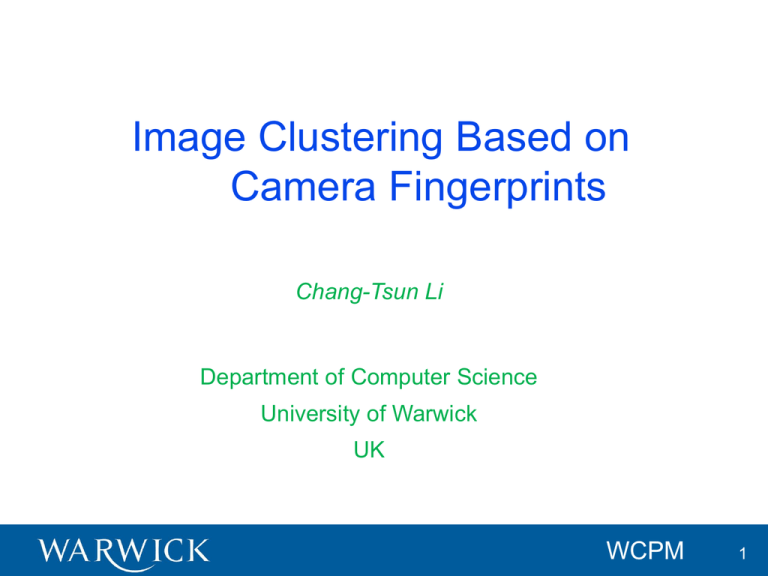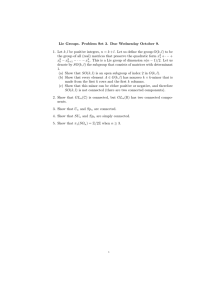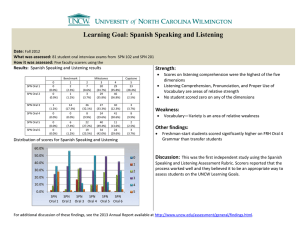Image Clustering Based on Camera Fingerprints WCPM Chang-Tsun Li
advertisement

Image Clustering Based on
Camera Fingerprints
Chang-Tsun Li
Department of Computer Science
University of Warwick
UK
WCPM
1
Digital Image Acquisition Process
Lens
CFA
Scene
Sensor
CFA
Interpolation
PostProcessing
Photo
CFA: Colour Filter Array
Bayer CFA
R
G
G
B
mapping of CFA to
sensor pixels
R
G
R
G
R
G
G
B
G
B
G
B
R
G
R
G
R
G
G
B
G
B
G
B
WCPM
2
What is Camera Fingerprint
• Lens aberration
• Sensor pattern noise
• Colour filter array (CFA) interpolation artefacts
• Camera response function
• Quantisation table of JPEG compression
Lens
Scene
CFA
Sensor
CFA
Interpolation
PostProcessing
Photo
WCPM
3
Camera Fingerprint for Multimedia
Forensics
Multimedia Forensics: The use of “fingerprints” left in
images by the imaging devices for
• source device identification
• source device linking
• content integrity verification
• image classification
WCPM
4
What is Sensor Pattern Noise
Sensor Pattern Noise (SPN) is the noise left in the
images by the sensors of digital imaging devices such
as cameras, camcorders and scanners.
SPN is mainly caused by
– manufacturing imperfection and
– different sensitivity of pixels to light due to the
inhomogeneity of silicon wafers.
Sensors made from the same silicon wafer possess
unique SPN because of the non-uniform imperfection.
SPN can differentiate cameras of the same model.
WCPM
5
“Traditional” SPN Extraction Method
Lukáš et al’s model for SPN extraction (IEEE TIFS
2006)
n I (i, j ) I ' (i, j )
I ' Weiner _ filter ( I )
– I is the original image
– I’ is the low-pass filtered version of I by the
Weiner filter applied in the wavelet transform
domain
– n is the extracted SPN
SPN is the high-frequency component of the image.
WCPM
6
Interference from Scene Details
Scene details, e.g., brick walls, tree leaves, or other kinds of
textures, contribute to the high-frequency components of images.
natural
image
SPN
a clean SPN
a contaminated SPN
WCPM
7
SPN Enhancement at Warwick
• C.-T. Li, "Source Camera Identification Using Enhanced Sensor
Pattern Noise," IEEE Trans. on Information Forensics and
Security, June 2010
• C.-T. Li and Y. Li, "Color-Decoupled Photo Response NonUniformity for Digital Image Forensics," IEEE Trans. on Circuits
and Systems for Video Technology, 2012
• X. Lin and C.-T. Li, "Preprocessing Reference Sensor Pattern
Noise via Spectrum Equalization," IEEE Trans. on Information
Forensics and Security, 2016 .
• X. Lin and C.-T. Li, "Enhancing Sensor Pattern Noise via
Filtering Distortion Removal," IEEE Signal Processing Letter,
accepted for publication in 2016
WCPM
8
Image Classification/Clustering
Scenario: A forensic investigator
• has a large set of images taken by an unknown number of
unknown digital cameras and
• wishes to cluster those images into a number of classes,
each including the images acquired by the same camera.
Each data point represents one image
Each cluster present one unknown device
WCPM
9
Challenges Facing Image Classification
The forensic investigator does not have the cameras that
have taken the images to generate reference SNPs for
comparison.
No prior knowledge about the number and types of the
imaging devices are available.
With a large dataset, exhaustive fingerprint comparison is
computationally prohibitive.
Given the shear number of images, analysing each image
in its full size is computationally infeasible.
WCPM
10
Image Classification – a MRF Approach
Step 1. Extract and enhance the fingerprint of each block cropped
from the images
Step 2. Establish a similarity matrix ρ for a Focus Set of M images
Step 3. Train the classifier based on the similarity matrix ρ.
For each fingerprint i, which is treated as a random variable
3.1. Assign a unique random class label
3.2. Calculate a reference similarity (i.e., a “soft” threshold)
3.3. Establish a membership committee (neighbourhood)
3.4. Update the class label iteratively based on the information
from the membership committee until there are no changes
of class labels to any SPN throughout a entire iteration
Step 4. Classify the rest of the dataset using the classifier
WCPM
11
Establishing Similarity Matrix
To establish an M × M similarity matrix ρ, the similarity between
any two enhanced SPNs i and j in the Focus Set is calculated
using
i , j
1
1
1.00
2
3
2
3
….
M
1.00
1.00
4
1.00
:
:
1.00
M
(i, j )
4
1.00
(ni n i ) (n j n j )
ni n i n j n j
, i, j {1,2,3,..., M }
WCPM
12
Classifier Training
• Each fingerprint (SPN) is treated as a random variable.
3.1. Assign a unique random class label to each SPN
3.2. Calculate a reference similarity r
inter-class similarity
intra-class similarity
Normally intra-class similarities >
inter-class similarities.
r
1 2
2
μ
similarity
1
r
μ2
Similarity
• A similarity less than r indicates that the two images are taken
by different devices, otherwise by the same device.
WCPM
13
Classifier Training
3.3. Establish a membership committee
For each SPN i , a membership committee Ci with c SPN
members from the focus set that are most similar to i is
established.
×
vv
vv
vv
WCPM
14
Classifier Training
3.4. Update the class label iteratively according to p(fi |ρ(i, Ci ), Li)
until there is no change of class label to any SPN in x consecutive
iterations
•
fi : class label of SPN i
•
LC
i { f i } { f j | j Ci }
•
ρ(i, Ci ) is the similarities between
SPN i and the members of Ci, i.e.,
•
p(fi |ρ(i, Ci ), Li): probability of
assigning fi given the conditions
•
ri: reference similarity (“soft”
threshold) of I
(i, Ci ) { (i, j ) | j Ci }
1
p ( f i | (i, C i ), Li )
exp[ U i ( f i , (i, C i ), Li )]
Zi
Zi
exp[ U ( f , (i, C ), L )]
f i Li
i
i
i
i
WCPM
15
Objective Function / Cost Function
U i ( f i , (i, Ci ), Li ) s( f i , f j ) (i, j ) ri
jCi
1
s( f i , f j )
1
inter-class similarity
intra-class similarity
, if f i f j
, if f i f j
The combination of the s(.) and ρ(.) says,
μ1
r
μ2
similarity
• a penalty (i.e. positive value) will be incurred
Similarity
if ρ(i,j) > r and a different label than fi is to be assigned to i or
if ρ(i,j) < r and the same label as fj is to be assigned to i
• a reward (i.e. negative value) will be given
if ρ(i,j) < r and a different label than fi is to be assigned to i or
if ρ(i,j) > r and the same label as fj is to be assigned to i
WCPM
16
Image Classification
The centroids of the image clusters provided by the
classifier training process at the end of Step 3.4 are
used to classify the images.
To classify an image x, we compare the similarity of its
SPN to the centroid of each identified cluster and
classify it to the class with its centroid closest to the
image.
WCPM
17
Classifier Training - Simulation
Clustering
Initial label configure: Each
pattern in
is progress
assigned…..
an unique label / colour
WCPM
18
Final Classification
WCPM
19
Table 1. Classification error rate. c is the size of the membership committee.
Experimental Results
Misclassification rates: 1200 images taken by six cameras, each taking 200. Class
identification stops when there are no class label changes throughout an iteration.
Block Size
c
256 × 256
256 × 512
512 × 512
Focus set size (M)
Focus set size (M)
Focus set size (M)
120
300
120
300
120
300
M-1
8.889
4.000
3. 778
1.333
1.444
1.444
M/2
8.333
4.000
2.333
1.333
1.444
1.444
M/3
8.333
4.000
2.333
1.333
1.444
1.444
M/4
8.333
4.000
2.333
1.333
1.444
1.556
M/5
8.333
4.000
3. 778
1.222
1.444
1.444
c: the size of the membership committee
M: the size of the focus set
A misclassification rate in the range (1.2 ~ 1.6) is likely to be the best
the system can achieve.
WCPM
20
Conclusions
Multimedia forensics using “fingerprint” left in the
images by the imaging devices has emerged as a new
area of research in the last few years.
Sensor pattern noise (SPN) is one of the most
promising types of fingerprint.
The “traditional” SPN extraction method is unable to
cope with the interference of scene details.
The proposed classifier is feasible, but is unable to
classify images without clean SPNs provided by the
proposed SPN enhancer.
WCPM
21

![[Motion 2014_10_M02] Course Recommendations for University Studies Approval—Sept. 29](http://s2.studylib.net/store/data/012060465_1-aab47185195dbd544a4d708bd882f391-300x300.png)

